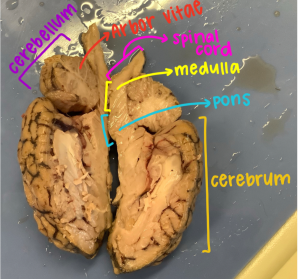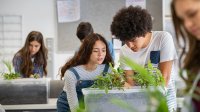How to Give Science Lessons a Real-World Boost
Teachers can inject new life into old labs by adding elements that prompt students to show creativity and make connections to prior learning.
Your content has been saved!
Go to My Saved Content.If you were to peek into a science classroom today, do you think it would look the same as when you were a student? When I was in high school, it was notes, lab, test, repeat. Today, many science classrooms are interactive, exploratory, and creative. Kids are developing experimental plans, drawing conclusions based on evidence, and creating products to share their knowledge with the world.
Some of those old science labs and activity ideas were good, but maybe too prescriptive. As students, we all did the same thing and had the same end product, similar to following a recipe to bake a cake. I remember filling out lab packets over and over again and not really enjoying the experience after the lab itself.
How can we as educators take those original ideas and update them to meet the needs of our students today so that they are motivated and engaged in our classrooms? Here are some examples of updated science lessons that hold students’ interest.
Design a Lab Around a Guiding Question
Original lab: Soak a dry chicken bone in vinegar overnight and see how the density changes.
Updated version: Develop an experiment that explores an environmental impact on bone density over time.
To implement this idea in your classroom, start with a guiding question. For example, “How do everyday choices alter bone density?” Give students a good database to use, and let them quickly research this question. Have each group share out what they found and generate a list of questions they still have. The goal is for them to have more questions than answers at this point.
Challenge each group to develop their own more specific guiding question that they will use to launch an investigation.
To help students develop a procedure for testing their guiding question, I like to incorporate time for them to present their procedures to the class to gain feedback. Next, students run their experiment and collect data. They create charts and graphs and analyze the results. Once the lab is complete, they develop conclusions based on evidence and prepare to share their findings with others. I challenge students to create a product that shares this information in a way that encourages others to keep bones strong and healthy.
I make suggestions such as creating infographics using Canva or Keynote, recording short video public service announcements using Clips or Quik, or creating breaking news articles using Creative Cloud Express or Pages.
Annotated Dissections
Original assignment: Dissect the specimen, and label the diagrams in the packet.
Updated version: Create an annotated image of your specimen to identify at least five structures.
As an anatomy teacher, I have several labs that require dissection or labeling of images. I have found that giving students a list of structures to locate on an actual specimen and then having them create their own annotated image provides a much deeper understanding of the lab.
Instead of labeling a stock photo of the brain with arrows pointing at specific structures, have students take a picture of the specimen on their table and label at least five things they can clearly identify. I tell students to be prepared to explain how they know what they are pointing at.

When kids are searching for fill-in-the-blank answers, they are looking for one correct response. When they have to create their own blanks, or lines, they must analyze the entire photograph and compare it with diagrams and text, which requires a higher level of thinking. There is so much more conversation happening, where kids are asking each other questions and comparing multiple images for accuracy. They pay more attention to the details and better understand the structures.
Sketchnote Writing Summaries
Original assignment: Read the article and write a summary of what you learned.
Updated version: Read the article and create a sketchnote that shows how the information you are reading relates to your life and what we have learned previously.
I’ve tried to incorporate more scientific journal articles in my classroom this year and am always looking for ways to see if kids truly understand what they’re reading. I’ve found a lot of success in my class with sketchnoting a journal publication.
As students work through the scientific paper, they take notes on things they think are most important and then create small sketches or drawings that help them solidify the concepts. I love the variety of work that is submitted and how students are able to make deeper connections to the content they are reading. They start to see how the information pertains to them as an individual. I believe it shifts their thinking from “What is this about?” to “How does this relate to me?”
Seed Studies: Adopt a Plant
Original assignment: Look at seeds and determine their method of dispersal.
Updated version: Plant seeds and measure plant growth over time. Set up an Adopt a Plant program at school.
In seventh-grade science, students selected a seed to plant. We studied that seed and determined its method of dispersal and researched its needs to germinate. Students then planted the seeds and cared for the plant for about two weeks. I asked teachers at school to adopt a plant from a student to take home and grow. Students created a guide for their plant to share with the teacher. This guide gave the teacher all the information they needed, such as sunlight and water requirements, as well as other information the students thought the teachers might find interesting.
Students were excited, motivated, and empowered to teach their teachers what they had learned in class. At the end of the school year, students checked back with their teachers to find out if their adopted plant had survived. One teacher was actually inspired to start her own home garden from this and shared pictures with the kids of how much her adopted plant had thrived at her house.
When students are developing labs, creating their own images, teaching others, and applying what they have learned to their own life, they’re more engaged in the content. As an educator, I’m always looking for ways to challenge my students to dig a little deeper and make more meaningful connections to our curriculum. I also want to dig a little deeper and create more meaningful lessons to push student thinking beyond expectations.
